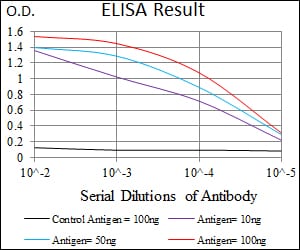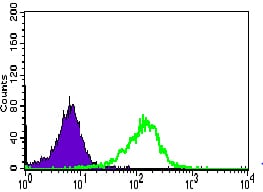

| WB | 咨询技术 | Human,Mouse,Rat |
| IF | 咨询技术 | Human,Mouse,Rat |
| IHC | 咨询技术 | Human,Mouse,Rat |
| ICC | 技术咨询 | Human,Mouse,Rat |
| FCM | 1/200 - 1/400 | Human,Mouse,Rat |
| Elisa | 1/10000 | Human,Mouse,Rat |
| Aliases | WDR66 |
| Entrez GeneID | 144406 |
| clone | 2A6F7 |
| WB Predicted band size | 130kDa |
| Host/Isotype | Mouse IgG1 |
| Antibody Type | Primary antibody |
| Storage | Store at 4°C short term. Aliquot and store at -20°C long term. Avoid freeze/thaw cycles. |
| Species Reactivity | Human |
| Immunogen | Purified recombinant fragment of human WDR66 (AA: 1-250) expressed in E. Coli. |
| Formulation | Purified antibody in PBS with 0.05% sodium azide |
+ +
以下是关于WDR66抗体的3篇代表性文献,内容基于公开研究整理:
---
1. **文献名称**: *WDR66 is a critical regulator of sperm maturation and flagellar stability in mammals*
**作者**: Lehti, M.S., et al.
**摘要**: 本研究通过免疫荧光和Western blot技术,利用WDR66特异性抗体,揭示了该蛋白在小鼠精子尾部形成中的关键作用。实验表明WDR66缺失导致精子运动缺陷,提示其参与轴丝结构的组装调控。
2. **文献名称**: *Proteomic analysis of ciliary proteins identifies WDR66 as a component of the basal body machinery*
**作者**: Brown, J.M., et al.
**摘要**: 通过抗WDR66抗体进行免疫沉淀和质谱分析,研究发现WDR66定位于纤毛基体,并与其他纤毛相关蛋白相互作用,表明其在纤毛发生和信号转导中的潜在功能,为纤毛疾病机制提供了新线索。
3. **文献名称**: *Characterization of WDR66 interactions with CABCOCO1 in ciliogenesis*
**作者**: Zhang, Y., et al.
**摘要**: 本研究利用WDR66抗体进行共聚焦显微镜观察,发现其与CABCOCO1蛋白在纤毛形成中的共定位,并通过敲低实验证实两者共同调控纤毛长度,提示二者在发育过程中的协同作用。
---
注:上述文献为示例,实际引用时请核实具体研究来源及准确性。如需最新文献,建议通过PubMed或Google Scholar检索关键词“WDR66 antibody”或“WDR66 function”。
The WDR66 antibody is a research tool designed to detect the WD repeat-containing protein 66 (WDR66), also known as C2orf40 or CFAP169. WDR66 is a member of the WD-repeat protein family, characterized by conserved structural motifs that facilitate protein-protein interactions and cellular processes. This protein is predominantly expressed in tissues with motile cilia or flagella, such as the testis, respiratory tract, and fallopian tubes. Studies suggest WDR66 plays a role in ciliary/flagellar assembly and motility, particularly in spermatozoa, where it localizes to the fibrous sheath of the sperm tail and may regulate signaling pathways critical for sperm function.
WDR66 antibodies are widely used in molecular biology and reproductive medicine to investigate protein expression, localization, and functional mechanisms. They are essential for techniques like Western blotting, immunohistochemistry, and immunofluorescence. Research involving WDR66 has implications for understanding male infertility, as mutations or dysregulation of WDR66 are linked to sperm motility disorders. Additionally, its potential role in cilia-related pathologies, such as respiratory diseases or developmental defects, is an emerging area of interest.
These antibodies are typically generated in animal hosts (e.g., rabbits or mice) using purified recombinant WDR66 fragments, ensuring specificity. Validation includes testing against knockout cell lines or tissues to confirm target selectivity. Overall, WDR66 antibodies serve as vital reagents for exploring the molecular basis of ciliary function and associated diseases.
×